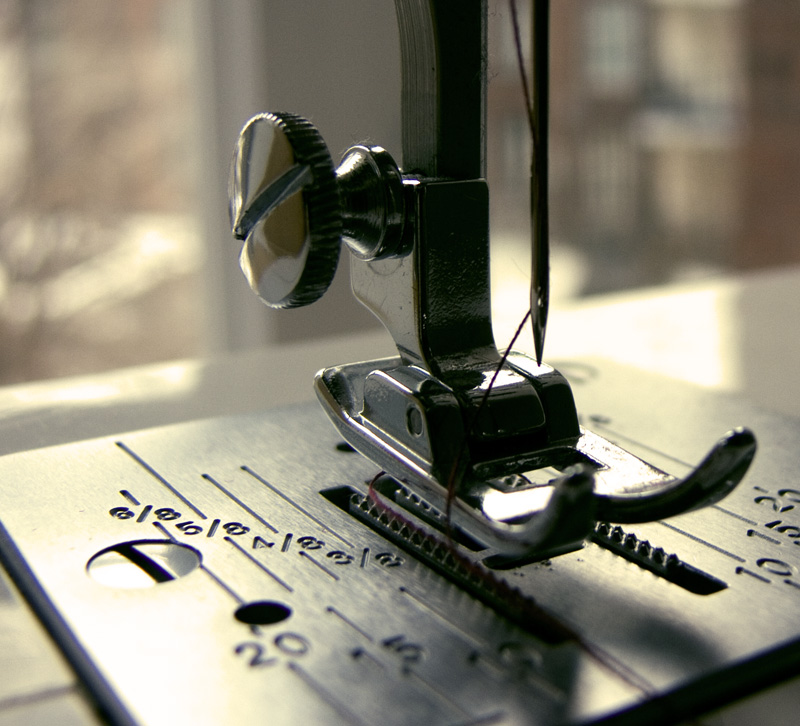Presser foot on:
[Wikipedia]
[Google]
[Amazon]
 A presser foot is an attachment used with
A presser foot is an attachment used with

 A presser foot is an attachment used with
A presser foot is an attachment used with sewing machine
A sewing machine is a machine used to sew fabric and materials together with Thread (yarn), thread. Sewing machines were invented during the first Industrial Revolution to decrease the amount of manual sewing work performed in clothing companies. ...
s to hold fabric flat as it is fed through the machine and stitched. Sewing machines have feed dogs in the bed of the machine to provide traction and move the fabric as it is fed through the machine, while the sewer provides extra support for the fabric by guiding it with one hand. A presser foot keeps the fabric flat so that it does not rise and fall with the needle and pucker as it is stitched. When especially thick workpieces are to be sewn, such as quilts, a specialized attachment called a walking foot is often used rather than a presser foot.
Presser feet are typically spring-hinged to provide some flexibility as the workpiece moves beneath it. Presser feet have two toes, one to hold the fabric down on either side of the needle.
Types of presser feet

Shank
Different manufacturers have produced machines with one of three types of presser foot shank in mind. These are the ''low shank'', ''high shank'', and the ''slant shank'' presser foot. A low shank presser foot has a distance from the bottom of the foot to the center of the thumbscrew; a high shank foot has a distance; a slant shank foot is distinctly slanted. The kind of foot a given machine requires is not interchangeable: a low-shank machine will only accept a low shank presser foot, and a high shank machine only a high-shank presser foot, though within these categories any low shank or high shank foot will fit any corresponding low shank or high shank machine; exceptionally, a slant shank foot can ''only'' be used with aSinger
Singing is the act of creating musical sounds with the voice. A person who sings is called a singer, artist or vocalist (in jazz and/or popular music). Singers perform music (arias, recitatives, songs, etc.) that can be sung with or withou ...
slant needle machine and no other (likewise, such a machine can accept no other kind of foot).Feet
The most commonly used presser feet are the ''all-purpose'' foot and the ''zipper'' foot, which come standard with most household machines. However, an array of specialized feet have also been designed for a number of uses. Among these are the following: *blind hem foot *button-attaching foot *buttonhole foot *darning
Darning is a sewing technique for repairing holes or worn areas in fabric or knitting using needle and thread alone. It is often done by hand, but it is also possible to darn with a sewing machine. Hand darning employs the darning stitch, ...
foot
*fringe foot
*gathering foot
*invisible zipper foot
*narrow hem foot called as well a rolled hem foot (comes in different sizes measured in mm of the hem)
*open-toe foot
* overedge/overcast foot
*pintuck foot (comes in different sizes measured in the number of grooves)
*piping
Within industry, piping is a system of pipes used to convey fluids (liquids and gases) from one location to another. The engineering discipline of piping design studies the efficient transport of fluid.
Industrial process piping (and accompa ...
/ cording foot
*quarter-inch seam foot (6mm)
*quilting quarter-inch seam foot
*roller foot
* satin stitch or decorative stitch foot
*straight-stitch foot
*tape attaching foot used for narrow ribbons, rick-rack, etc.
Most presser feet are made of steel or clear plastic; however, presser feet made of Teflon or other non-stick material are used for sewing with leather, plastic, vinyl and oilcloth.
References
{{sewing Sewing machines